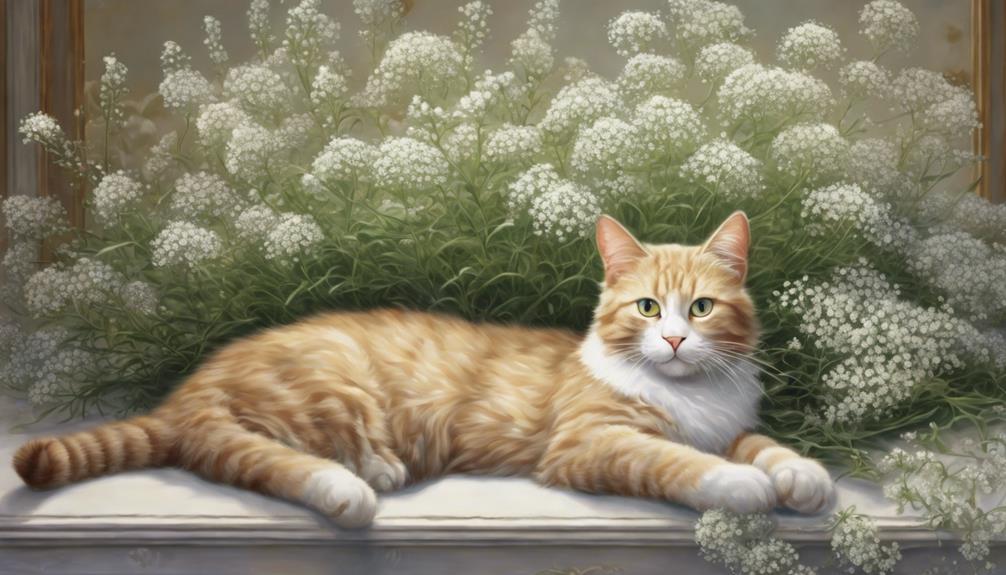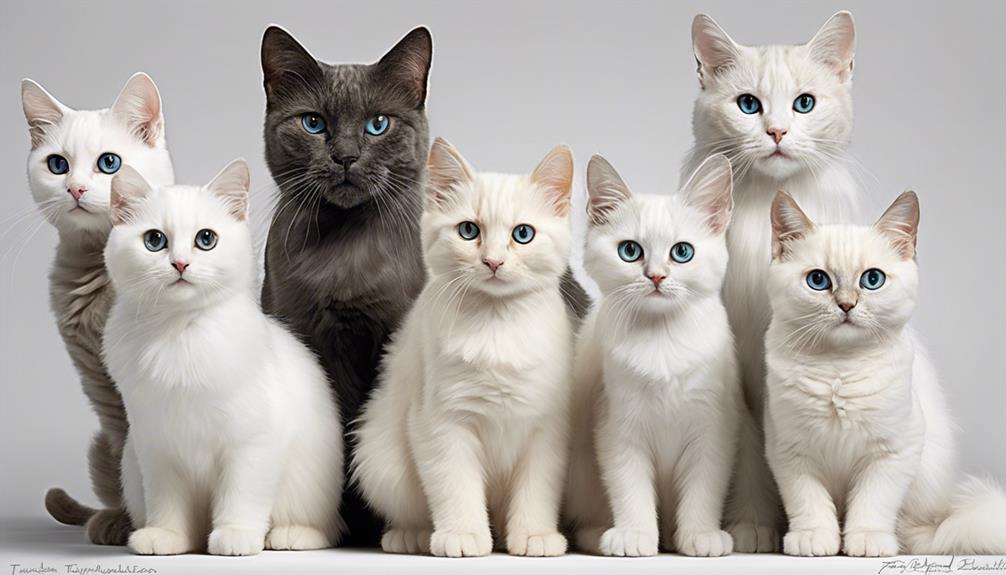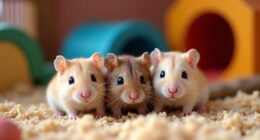To keep cats safe around baby's breath, it's important to prevent their access to these flowers containing saponin gyposenin, which can be toxic. Even small amounts could harm our feline friends, causing gastrointestinal issues like vomiting and diarrhea. Keep baby's breath out of reach to protect cats, and opt for safe floral alternatives. Immediate vet care is essential for severe cases. Supervise cats around these plants to prevent ingestion. Creating a safe environment by using barriers or deterrents can help avoid accidents. Protect your furry pals by staying informed about potential dangers lurking in your home's flora. More tips await.
Key Takeaways
- Place baby's breath out of reach to prevent accidental ingestion by cats.
- Opt for pet-safe floral alternatives for decorations.
- Supervise cats around baby's breath arrangements closely.
- Educate yourself on the risks of baby's breath for cats.
- Implement deterrents or barriers to keep cats away from harmful plants.
Understanding Cats and Babys Breath
Understanding why cats are susceptible to the toxicity of baby's breath flowers is essential for guaranteeing their safety around this plant. Cats are particularly vulnerable to the toxic effects of baby's breath due to the presence of saponin gyposenin in the flowers.
When cats ingest baby's breath, it can lead to gastrointestinal irritation, resulting in symptoms like vomiting and upset stomach. Even if a cat consumes only a small amount of baby's breath, it may still exhibit mild symptoms of toxicity. However, in severe cases of ingestion, immediate veterinary care is critical to prevent further complications.
To protect our feline friends, it's important to keep baby's breath out of their reach and create a safe environment free from this harmful plant. By understanding the potential risks that baby's breath poses to cats, we can take proactive measures to ensure their well-being and prevent any incidents of ingestion that could harm them.
Risks of Babys Breath for Cats
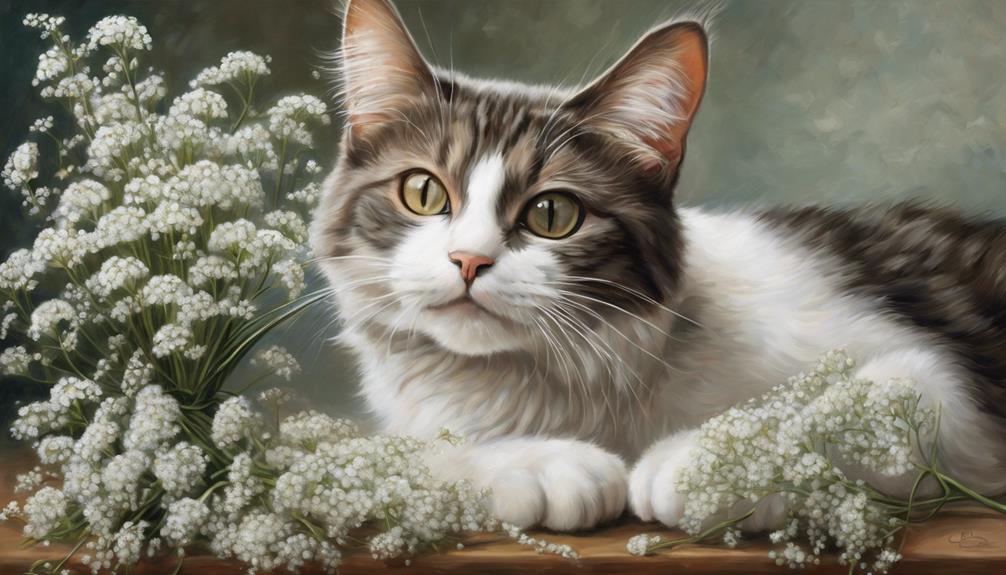
When cats come into contact with baby's breath flowers, they face potential toxicity risks due to the presence of saponin gyposenin. This beautiful plant, often used in floral arrangements, can be a toxic plant to cats if ingested.
The ingestion of baby's breath can lead to gastrointestinal irritation in our feline friends, causing symptoms like vomiting and diarrhea. It's vital to keep baby's breath out of reach of our curious companions to prevent accidental ingestion and potential poisoning.
If you suspect that your cat has consumed baby's breath, it's important to seek immediate veterinary care to address any potential toxicity concerns. Remember, prevention is key when it comes to protecting our beloved cats from the dangers of toxic plants like baby's breath.
Stay vigilant and keep these delicate flowers away from your furry friends to safeguard their safety and well-being.
Safety Precautions for Cats and Babys Breath
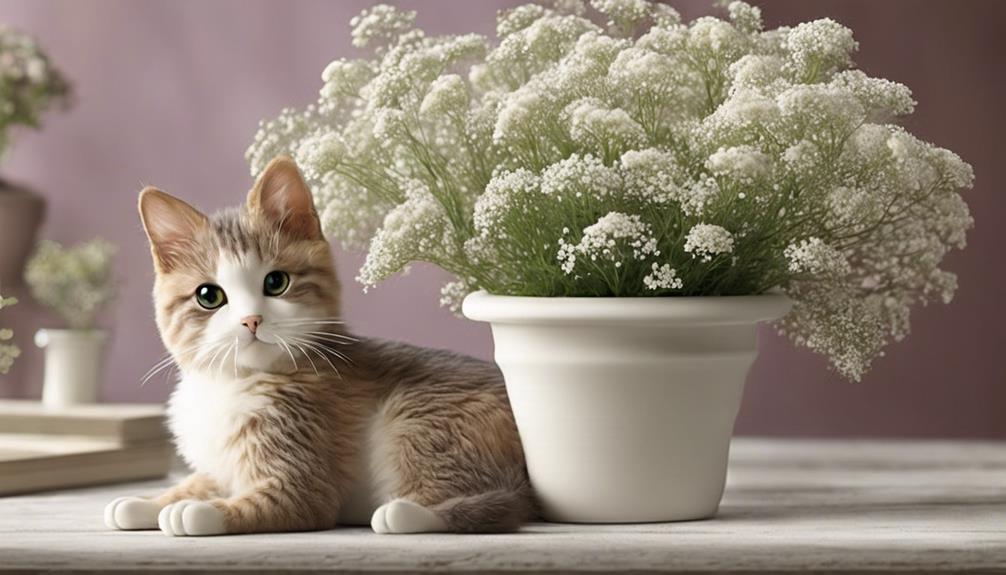
To safeguard our feline companions' well-being, it's important to implement safety precautions when it comes to cats and baby's breath plants. Baby's breath flowers may seem harmless, but they can pose a risk to our curious cats if ingested.
To protect our pets, it's vital to keep baby's breath plants out of reach. Educating ourselves about the potential harm baby's breath can cause to cats is essential in preventing any accidents.
Opting for pet-safe alternatives for home decorations guarantees a safe environment for our beloved feline friends. When baby's breath flowers are present, close supervision of our cats is necessary to avoid any unwanted interactions.
Signs of Gypsophila Poisoning in Cats

Keeping a close eye on our feline companions for signs of Gypsophila poisoning is vital for their well-being. If your cat has come into contact with this toxic plant, here are some key signs to watch out for:
- Vomiting: Cats may exhibit episodes of vomiting after ingesting Gypsophila.
- Diarrhea: Keep an eye out for any changes in your cat's litter box habits, as diarrhea can be a sign of poisoning.
- Lack of appetite and lethargy: If your cat suddenly loses interest in food and becomes unusually tired, it could indicate Gypsophila poisoning.
If you notice any of these symptoms or behaviors in your cat, it's essential to act promptly. Contact your veterinarian immediately and provide them with all the necessary information about your cat's recent activities. Remember, a quick response can make a significant difference in your cat's recovery from upset stomach caused by Gypsophila poisoning.
Managing Cats Around Babys Breath

Advisably, we should be mindful of our cats' proximity to baby's breath to prevent potential toxicity issues. Baby's breath, when ingested by cats, can lead to gastrointestinal irritation, resulting in symptoms such as upset stomach, vomiting, and diarrhea.
To manage cats around baby's breath, it's essential to keep this toxic plant out of their reach. This can be achieved by placing floral arrangements containing baby's breath in areas inaccessible to our feline friends. Additionally, supervising cats when they're near these arrangements is vital to avoid any accidental ingestion that could lead to poisoning.
Importance of Supervision

Monitoring our cats' interactions with baby's breath is essential to prevent potential ingestion and guarantee their safety. When it comes to keeping our feline friends safe around these delicate flowers, close supervision plays an important role. Here are some key points to keep in mind:
- Regular Check-ins: Make it a habit to check on your cats and the surroundings where baby's breath is kept to make sure they aren't accessing the flowers when you're not around.
- Creating Boundaries: Establish clear boundaries to prevent cats from reaching the baby's breath flowers, such as placing them in areas that are inaccessible to your curious pets.
- Immediate Intervention: If you notice your cat showing interest in the baby's breath, intervene promptly to redirect their attention and remove any potential danger.
Separating Cats and Babys Breath
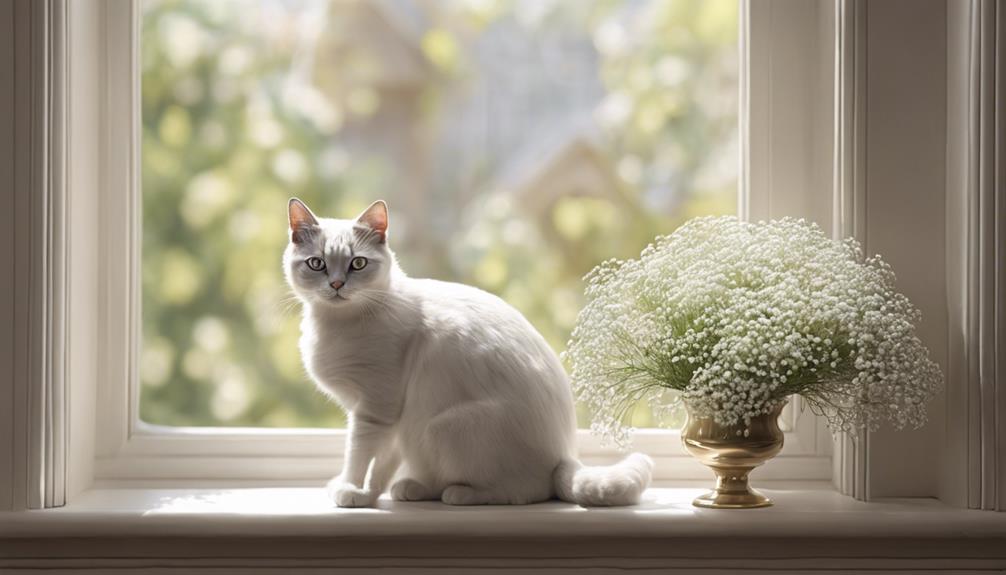
When it comes to keeping our feline friends safe around baby's breath, it's important to establish safe spaces for our cats, such as closed rooms or high shelves.
Additionally, considering alternative flower arrangements can help prevent any potential harm to our curious companions.
Monitoring our cat's behavior around baby's breath arrangements is vital to make sure they stay away from any toxic parts.
Safe Spaces for Cats
To ensure the safety of our feline friends, it's essential to set up a secure and welcoming space away from baby's breath flowers within our homes. Here are some tips to create a safe haven for your cats:
- Designated Area: Establish a specific room or area where cats can retreat, play, and relax without any exposure to baby's breath.
- Comfortable Environment: Equip their space with cozy bedding, interactive toys, and scratching posts to keep them entertained and content.
- Vertical Options: Consider adding cat trees or shelves to provide vertical space for climbing and lounging, ensuring they have a retreat away from any harmful plants.
Alternative Flower Arrangements
As we ensure our cats' safety around baby's breath flowers, exploring alternative flower arrangements can provide a practical solution to keep our feline companions protected. Placing baby's breath flower arrangements in areas inaccessible to cats, such as high shelves or closed rooms, is a smart choice.
Opting for alternative cat-safe flowers like roses, sunflowers, or orchids in arrangements can add color and beauty without posing any risks to our curious pets. Additionally, considering the use of artificial or silk flowers instead of real baby's breath can help eliminate toxicity concerns altogether.
Creating separate spaces for floral arrangements and cats, along with implementing barriers like baby gates or closed doors, guarantees our beloved felines stay safe and healthy while still enjoying a touch of nature indoors.
Monitoring Cat Behavior
Our priority is closely monitoring our cats' behavior around baby's breath flowers to prevent any potential ingestion risks. To guarantee our feline friends stay safe, we can take the following precautions:
- Keep cats separated from baby's breath bouquets at all times.
- Watch for any signs of curiosity or attempts by cats to nibble on baby's breath.
- Create physical barriers or use deterrents to keep cats away from baby's breath arrangements.
Hygiene Practices for Cat Safety
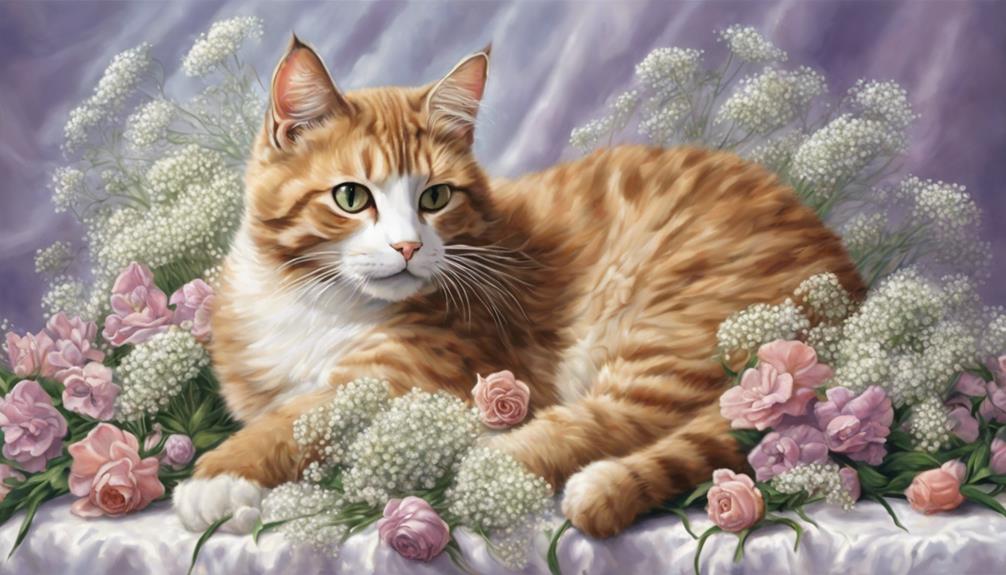
Maintaining good hygiene practices is essential for ensuring the safety of cats in a household with babies. To prevent the spread of illnesses like toxoplasmosis, it's important to wash hands thoroughly after handling cat litter. This simple step can go a long way in safeguarding both your feline friend and your family.
Pregnant women and children should steer clear of cat litter boxes to minimize the risk of toxoplasmosis transmission. Promptly cleaning up any pet messes and ensuring that babies are kept away from the litter boxes are key for maintaining a hygienic environment.
Additionally, supervising interactions between cats and babies during sleep is crucial to prevent suffocation risks. Using safety measures such as closing doors or using baby gates can help create a safe space for both your little one and your beloved cat.
Cats Indoors Vs. Outdoors

Keeping cats indoors provides them with a safer environment, shielding them from potential plant-related hazards like baby's breath. On the other hand, outdoor cats face increased risks of encountering and ingesting toxic plants, emphasizing the importance of monitoring their outdoor activities.
Indoor Cat Benefits
Opting to keep cats indoors rather than allowing them outdoors provides numerous benefits that contribute to their overall health and well-being. Indoor cats enjoy a longer lifespan, with an average of 12-20 years, compared to outdoor cats who typically live only 2-5 years.
They're also at a lower risk of injuries from traffic accidents, predators, and fights with other animals. Additionally, indoor cats are less likely to contract diseases, parasites, or infections spread by outdoor exposure.
Keeping our feline friends inside not only guarantees their safety but also reduces their exposure to toxic substances, plants, and chemicals commonly found outdoors. By opting for an indoor lifestyle, we can help protect our beloved cats and contribute to biodiversity conservation by preventing them from preying on local wildlife populations.
Outdoor Cat Risks
Reducing the risks faced by outdoor cats compared to their indoor counterparts includes the potential exposure to toxic plants like baby's breath. When a cat ate a toxic plant, such as baby's breath, it can lead to serious health issues.
Outdoor cats have a higher likelihood of encountering harmful plants while exploring the outdoors. To mitigate these risks, consider supervising outdoor cats and creating a cat-friendly outdoor space that's free from toxic plants.
Keeping cats indoors markedly reduces the chances of plant ingestion and poisoning. By understanding the dangers that outdoor cats face from toxic plants in gardens or natural environments, we can take proactive steps to ensure their safety and well-being.
Behavioral Considerations

When preparing cats for the arrival of a new baby, it's important to take into account their behavioral responses and potential signs of jealousy. Cats can exhibit signs of jealousy through behaviors like excessive meowing or acting out destructively.
To help ease this change for your feline friend, consider the following:
- Maintain Routine: Keeping a consistent schedule for your cat when the baby arrives can help reduce stress and anxiety for them, providing a sense of normalcy in their environment.
- Supervised Interactions: Monitoring interactions between toddlers and cats is essential. It helps build a safe and positive relationship while teaching children how to play with cats using appropriate toys.
- Use of Pheromone Therapy: Introducing cats to newborn babies can be made smoother with the use of pheromone therapy. This can help calm the cat and create a more harmonious environment for everyone in the household.
Preventing Suffocation Risks
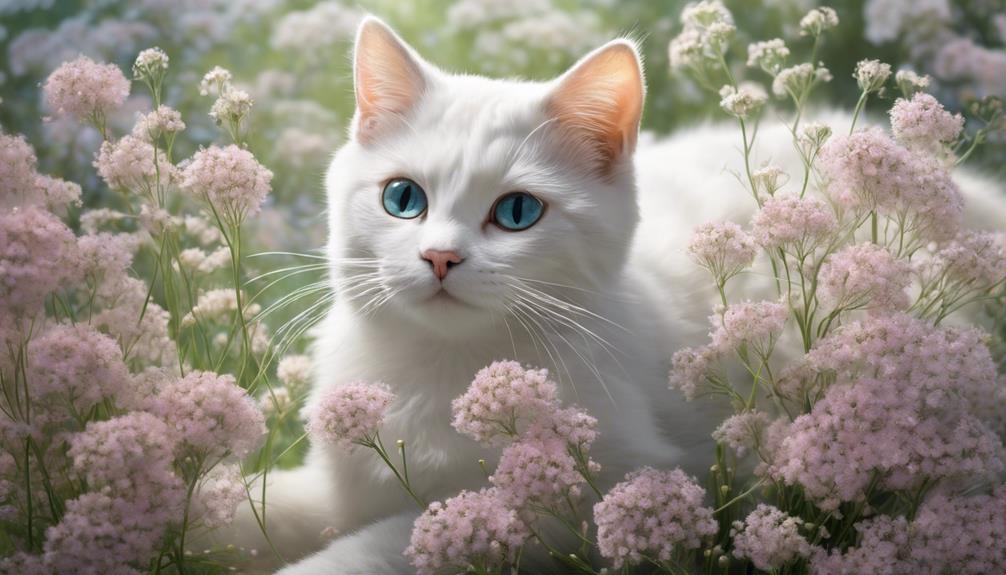
To prevent suffocation risks, it's vital to supervise interactions between cats and babies at all times. Cats are curious creatures, and their natural behavior may pose a danger to infants, especially when it comes to sleeping situations.
It's essential to keep cats away from babies during sleep to avoid any potential suffocation hazards. Using baby gates or closing doors to separate cats from infants during sleep can help create a safe environment for both the cat and the baby.
Educating all family members on the importance of supervising cats around babies is key in ensuring the well-being of the little ones. Remember, even though cats can be loving companions, their presence near infants can be potentially toxic.
Handling Cat Litter Safely

When handling cat litter, it's important to:
- Practice safe disposal methods.
- Consider using eco-friendly options.
- Always wash our hands thoroughly afterward.
By following these steps, we can minimize the risk of exposure to potential infections and keep ourselves and our feline friends healthy.
Safe Litter Disposal
When handling cat litter for disposal, remember to always wear gloves to prevent the spread of bacteria and parasites. It's essential for both your health and the environment.
Here are some tips for safe litter disposal:
- Seal used cat litter in a tightly closed bag to avoid contamination.
- Never flush cat litter down the toilet to prevent plumbing issues and environmental harm.
- Consider eco-friendly options for a sustainable disposal method.
These practices help maintain cleanliness and protect our surroundings. By following these simple steps, we can guarantee a safe and hygienic environment for both our feline friends and ourselves.
Use Eco-Friendly Litter
Choosing eco-friendly litter for your cat not only benefits the environment but also promotes a healthier living space for both your feline companion and your family. Eco-friendly litters, made from sustainable materials like corn, wheat, or recycled paper, are biodegradable and reduce the environmental impact of traditional clay litters.
They offer excellent odor control and clumping abilities while being safer for both cats and babies due to the absence of harmful chemicals or dust. By opting for eco-friendly options, you reduce the risk of your cat ingesting toxic substances that could lead to an upset stomach, possibly even affecting your little one.
Prioritizing eco-friendly litter is a simple yet impactful way to create a safer and healthier environment for everyone in your home.
Wash Hands Thoroughly
After scooping the cat litter, remember to wash your hands thoroughly with warm water and soap for at least 20 seconds to prevent the spread of bacteria and parasites. Important handwashing is essential, especially for pregnant women and children, to avoid potential health risks like toxoplasmosis from cat feces.
Here are some essential tips for handling cat litter safely:
- Use warm water and soap for at least 20 seconds.
- Scrub all parts of your hands, including between your fingers and under your nails.
- Dry your hands with a clean towel or air dryer.
Signs of Jealousy in Cats
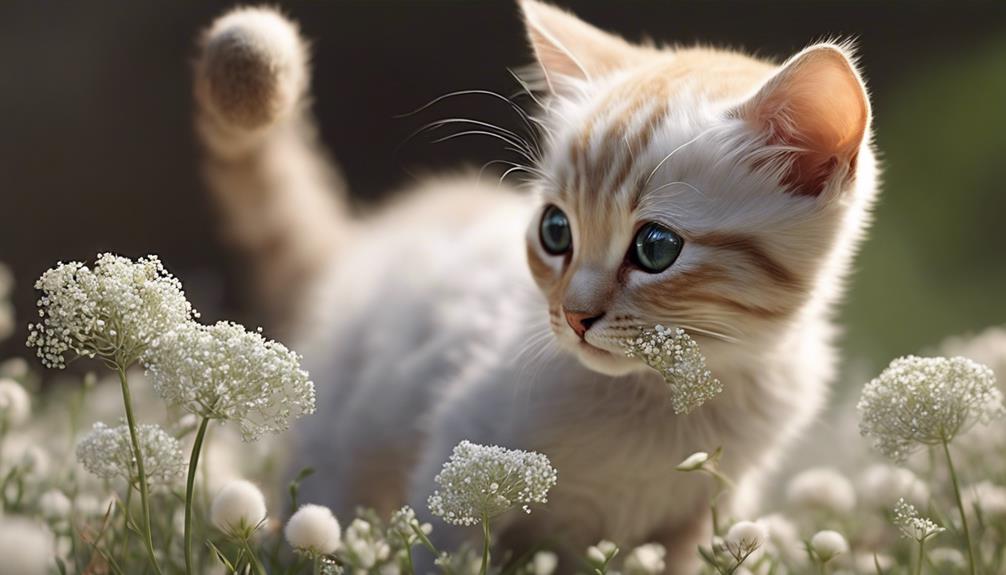
Noticing signs of jealousy in cats can help us address their emotions effectively when introducing a new baby into the household. Cats may display jealousy through behaviors like increased meowing, seeking more attention, or even acting out territorially or aggressively towards the baby. It's important to recognize these signs early on to prevent any potential issues and guarantee a smooth changeover for your feline friend.
Changes in routine or environment can trigger feelings of jealousy in cats towards new family members, leading to stress and anxiety. By understanding these signs and addressing them promptly, we can create a harmonious atmosphere at home for both our cat and the new baby.
Observing your cat's body language and behavior closely can provide valuable insights into their emotional state. Providing extra love and attention to your cat, along with gradual introductions to the baby, can help alleviate feelings of jealousy and promote a positive relationship between your cat and the new addition to the family.
Washing Hands After Cat Interactions

After spending time with our furry friends, it's essential to remember the importance of proper hand hygiene. Washing our hands thoroughly with soap and water for at least 20 seconds can greatly reduce the risk of spreading bacteria and potential illnesses.
Maintaining cleanliness post-cat interactions is key to ensuring the well-being of both our pets and ourselves.
Post-Cat Interaction Hygiene
When handling cats, it's vital to wash our hands thoroughly with soap and water to reduce the risk of spreading bacteria or parasites. Proper hand hygiene after interacting with our feline friends is essential for maintaining a healthy environment.
Here are some key points to remember:
- Soap and water are our best allies for clean hands.
- Scrub for at least 20 seconds to guarantee thorough cleaning.
- Remember to wash up before any mealtime or touching our faces to keep germs at bay.
Handwashing Best Practices
Proper handwashing after interacting with cats is essential for reducing the risk of spreading bacteria and parasites. It's important to wash our hands thoroughly with soap and water for at least 20 seconds after any contact with our feline friends. This simple act of hand hygiene can help prevent the potential transmission of diseases like toxoplasmosis, especially important for pregnant women, children, and those with weakened immune systems. By practicing regular handwashing after pet interactions, we create a healthier environment for both our beloved cats and ourselves.
| Handwashing Best Practices | Instructions |
|---|---|
| Use Soap | Create a good lather |
| Scrub Thoroughly | Make sure all surfaces are covered |
| Wash for 20 Seconds | Sing a short song to keep track |
| Dry with a Clean Towel | Pat hands gently to dry thoroughly |
Importance of Cleanliness
Emphasizing the importance of cleanliness, we always wash our hands thoroughly after interacting with our cats to prevent the spread of bacteria and potential illnesses. Cat fur and dander can harbor allergens and germs, underscoring the necessity of proper hand hygiene. To maintain good health and safety for both ourselves and our feline companions, we follow these practices:
- Thorough Handwashing: After petting or playing with our cats, we scrub our hands with soap and water for at least 20 seconds.
- Avoiding Face Contact: We refrain from touching our faces after touching our cats to minimize the risk of transferring any harmful bacteria.
- Regular Cleaning: Cleaning up cat fur and dander around the house prompts us to wash our hands promptly, safeguarding against potential health hazards.
Creating a Safe Environment
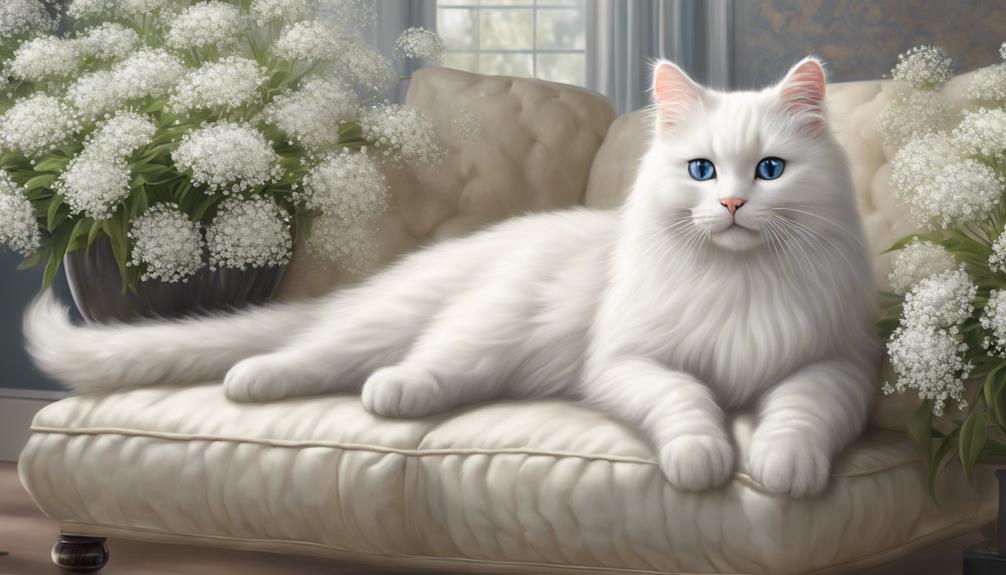
To guarantee the safety of our feline friends, it's imperative to carefully control the presence of baby's breath plants within their reach. Cats are curious creatures, and the allure of these delicate flowers may lead them to explore and potentially ingest them. As responsible pet owners, we must take proactive measures to create a safe environment for our beloved companions.
Placing baby's breath plants out of reach is a simple yet effective way to prevent any unwanted interactions. Opting for pet-safe alternatives in floral arrangements can also eliminate the risk of toxicity if ingested in a larger quantity. Additionally, using deterrents or barriers can help keep cats away from baby's breath flowers, further reducing the chances of exposure.
It's essential to monitor our cats closely when these plants are around, ensuring they don't come into contact with them. Educating ourselves on the signs of plant toxicity in cats equips us to quickly identify any issues and take necessary action. By implementing these strategies, we can create a safe and secure environment where our cats can thrive without encountering any harm from baby's breath plants.
Frequently Asked Questions
Can Cats Be Around Baby's Breath?
Cats should not be around baby's breath due to its toxicity. Ingestion can lead to gastrointestinal issues. Supervising cats near this flower is important. If a cat consumes baby's breath, immediate vet care is essential.
Is It Safe to Have Cats Around Babies?
It's important to think about safety when having cats around babies. Supervision is key to avoiding accidents. Ensuring a secure environment for both pets and infants is essential. We always prioritize their well-being.
How Do I Keep Cats Away From My Newborn?
We guarantee our newborn's safety by keeping cats away. Using deterrents like bitter sprays, placing items out of reach, and supervising interactions are key. Our approach creates a harmonious environment for all family members.
How Do Cats React to Newborn Babies?
Cats may show curiosity, caution, or indifference when introduced to newborn babies. Some may exhibit anxious or territorial behavior. Monitoring interactions closely for safety is crucial. Initial behaviors like hiding or hissing are common.
Conclusion
To sum up, it's crucial to be proactive and vigilant when it comes to keeping cats safe around babies breath. By understanding the risks, taking safety precautions, and monitoring your feline friend closely, you can create a secure environment for both your cat and your baby's breath.
Remember, a little extra care goes a long way in ensuring the well-being of your beloved pet. So, let's keep those curious kitties out of harm's way and enjoy peace of mind knowing they're safe and sound.
